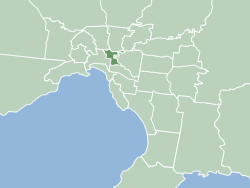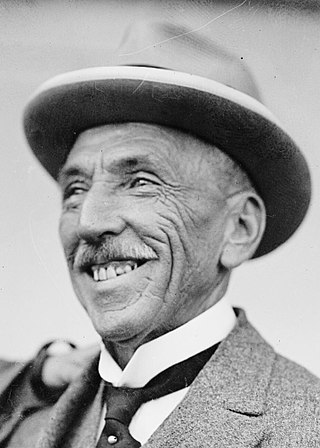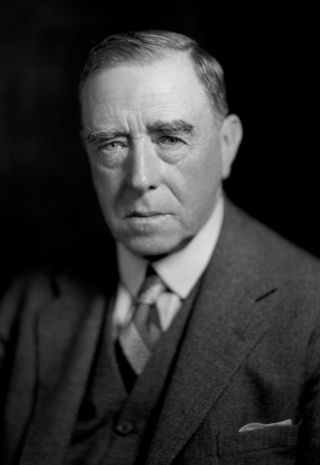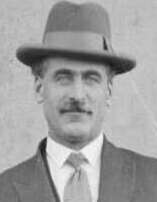
The Nationalist Party, also known as the National Party, was an Australian political party. It was formed in February 1917 from a merger between the Liberal Party and the National Labor Party, the latter formed by Prime Minister Billy Hughes and his supporters after the 1916 Labor Party split over World War I conscription. The Nationalist Party was established as a 'united' non-Labor opposition that had remained a political trend once the Labor party established itself in federal politics. The party was in government until electoral defeat in 1929. From that time it was the main opposition to the Labor Party until it merged with pro-Joseph Lyons Labor defectors to form the United Australia Party (UAP) in 1931. The party is a direct ancestor of the Liberal Party of Australia, the main centre-right party in Australia.

The City of Yarra is a local government area (LGA) in Victoria, Australia in the inner eastern and northern suburbs of Melbourne. It is the second smallest LGA in the state with an area of 19.5 square kilometres (7.5 sq mi), and in June 2021 it had a population of 91,543, making it the second most densely populated LGA, with around 4,695 people per square kilometre. The City of Yarra was formed in 1994 as a result of the amalgamation of the former Cities of Richmond, Collingwood, Fitzroy, and parts of Carlton North and parts of Alphington and Fairfield.

The City of Darebin is a local government area in Victoria, Australia, in the northern suburbs of Melbourne. It has an area of 54 square kilometres (20.8 sq mi) and in June 2018 Darebin had a population of 161,609. Municipal offices are located at 350 High Street, Preston.

The Division of Bendigo is an Australian electoral division in the state of Victoria. The division was proclaimed in 1900, and was one of the original 65 divisions to be contested at the first federal election. It is named for the city of Bendigo.

Candy Celeste Broad is an Australian politician. She has been a Labor Party member of the Victorian Legislative Council from September 1999 to May 2014, first representing the electorate of Melbourne North Province until 2006, and then as a Member for the Northern Victoria region.

The Victorian Greens, officially known as the Australian Greens Victoria, is the Victorian state member party of the Australian Greens, a green political party in Australia.

Richmond is an electoral district of the Legislative Assembly in the Australian state of Victoria. It is currently a 13 km2 electorate in the inner east of Melbourne, encompassing the suburbs of Richmond, Cremorne, Burnley, Abbotsford, Collingwood, Clifton Hill, North Fitzroy and Fitzroy. Historically a very safe seat for the Labor Party, Richmond has in recent elections become increasingly marginal against the Greens, who eventually won the seat at the 2022 Victorian state election.

The 1919 Australian federal election was held on 13 December 1919 to elect members to the Parliament of Australia. All 75 seats in the House of Representatives and 19 of the 36 seats in the Senate were up for election. The incumbent Nationalist Party government won re-election, with Prime Minister Billy Hughes continuing in office.

The City of Richmond was a local government area about 2 kilometres (1 mi) east of Melbourne, the state capital of Victoria, Australia. The city covered an area of 6.12 square kilometres (2.36 sq mi), and existed from 1855 until 1994.

Lionel Thomas Courtenay was an Australian businessman and politician. Born in Sydney, he left school at a young age but became general manager of an engineering company. He was involved in local politics, sitting on Mascot Council, Mosman Council and Sydney City Council. In 1932, he was elected to the New South Wales Legislative Council as a member of the United Australia Party. He left the Council in 1934 to contest the Australian Senate as a UAP candidate for New South Wales, in which he was successful. However, he died on 11 July 1935, 11 days after he formally became a Senator, necessitating the appointment of Guy Arkins to replace him.
This article provides information on candidates who stood for the 1931 Australian federal election. The election was held on 19 December 1931.

Local government in the Australian state of Victoria consists of 79 local government areas (LGAs). Also referred to as municipalities, Victorian LGAs are classified as cities (34), shires (38), rural cities (6) and boroughs (1). In general, an urban or suburban LGA is called a city and is governed by a City Council, while a rural LGA covering a larger rural area is usually called a shire and is governed by a Shire Council. Local councils have the same administrative functions and similar political structures, regardless of their classification.

The 1932 Victorian state election was held in the Australian state of Victoria on Saturday 14 May 1932 to elect 44 of the 65 members of the state's Legislative Assembly. The other 21 seats were uncontested.

The 1927 Victorian state election was held in the Australian state of Victoria on Saturday, 9 April 1927, to elect the 65 members of the state's Legislative Assembly.

The 1917 Victorian state election was held in the Australian state of Victoria on Thursday 15 November 1917 for the state's Legislative Assembly. 51 of the 65 Legislative Assembly seats were contested.
The Victorian Labor Party, officially known as the Australian Labor Party and commonly referred to simply as Victorian Labor, is the Victorian state branch of the Australian Labor Party (ALP). The branch is currently the ruling parting in the state of Victoria and is led by Jacinta Allan, who has served concurrently as premier of Victoria since 2023.
Stephen Jolly is an Australian politician, socialist activist, author and construction worker. He is a councillor in the City of Yarra and previously was the President and lead candidate for the Victorian Socialists during the 2018 state election.

The 2020 Victorian local elections were held on 24 October 2020 to elect the councils of 76 of the 79 local government areas in Victoria, Australia.

The 2024 Victorian local elections will be held in October 2024 to elect the councils of the 79 local government areas in Victoria.

The 1933 Victorian local elections were held on 24 August 1933 to elect the councils of 70 of the local government areas in Victoria, Australia. One council also held a referendum.



















